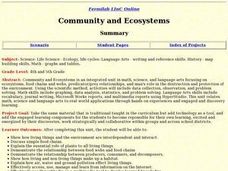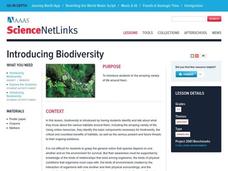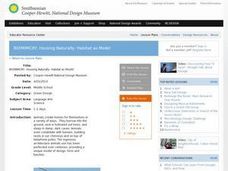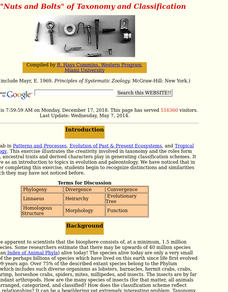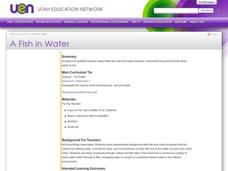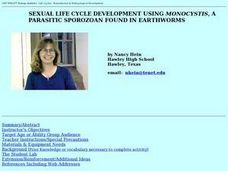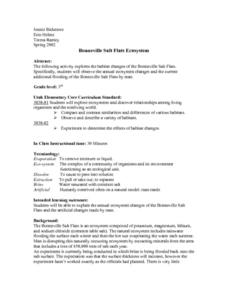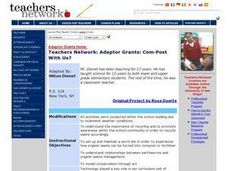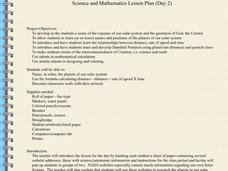Curated OER
Taking Charge of our Earth and its Resources
Students identify natural resources, discuss conservation and protection of them, and identify how pollution is harmful to the environment. Seven lessons on one page.
Curated OER
Community and Ecosystems
Students complete a unit of lessons on ecosystems. They participate in online activities, create a diorama, write journal entries, and develop a Hyperstudio multimedia project on a selected ecosystem.
Curated OER
Introducing Biodiversity
Students are introduced to the life around them. As a class, they discuss their prior knowledge about the habitats in their local area. Using the internet, they identify the basic components needed for biodiversity and the major...
Curated OER
The Tree of Life
Students discover the amount of diversity that exists in a local area using simple techniques that make observing biodiversity easy and enjoyable. They select a tree to study, collect vials of specimens, then identify the arthropod.
Curated OER
Species Diversity and Phylogeny
Students explore the classification system of organisms: taxonomy. They examine prepared slides of Protozoans and record information on a Taxonomy Recording Sheet. Two additional classifying activities are also included in this lesson.
Curated OER
Eco-Poetry
Students explore the Earth's various biomes and ecosystems using Internet research. They create a multimedia poem using the photos, sounds, and vocabulary from their research.
Curated OER
Making Connections, Linking Population and the Environment
Learners find out that all habitats have a carrying capacity. They explore how the world's human population has grown markedly in the 20th century, and that humans impact environmental health. Students investigate that people can and...
Curated OER
The Environment and Interactions of Living Organisms
Students study the environment and interactions of living organisms. They identify abiotic and biotic factors and create a foldable and vocabulary cards. They create a poster illustrating soil and watch a video to study symbiosis.
Curated OER
BIOMIMICRY, Housing Naturally: Habitat as Model
Students explore natural animal habitats. In this lesson on biomimicry and habitation design, students will use classroom and field examples to examine animal habitats. Students will construct a model of a natural animal habitat. This...
Curated OER
Mushrooms Can Save the World
Students use mushrooms to solve problems. In this environmental activity, students study how fungi have been used to combat environmental problems. Students design strategies that employ mushrooms to combat other environmental challenges.
Curated OER
Choose Your Defense: Spines, Vomit and Camouflage
Students investigate defensive mechanisms of insects and organisms. In this biology lesson, students draw imaginary caterpillars as well as imaginary parasites that will harm the caterpillar. Students utilize the Internet to discover...
Curated OER
Birds: Wetlands Ecosystems
In this birds worksheet, students click on the links to learn about the birds of the Wetlands and answer short answer questions about it. Students complete 7 questions total.
Curated OER
Current Events and Fish
Fifth graders examine current events impacting aquatic life in their communities. They search for newspaper, magazine and television reports for information about aquatic life in local bodies of water. Students can write letters to...
Curated OER
Endangered Species Furniture Project
Students work in groups to research an endangered species. They then refinish and paint a piece of furniture and incorporate facts and references about the animal they have researched.
Curated OER
The "Nuts and Bolts" of Taxonomy and Classification
Students develop classification scheme that meets the established rules of the Linnaean system. They write one page essay on classification choices.
Curated OER
A Fish in Water
First graders, with a goldfish as a class pet, practice the proper way to care for a pet and have responsibilities when it comes to taking care of the fish. As a class, the teacher reads the book "Fish Out of Water".
Curated OER
Streamflow
Learners discuss the topic of streamflow and how it occurs. They take measurements and analyze them. They interpret data and create their own charts and graphs.
Curated OER
SEXUAL LIFE CYCLE DEVELOPMENT USING MONOCYSTIS
High schoolers perform a lab to becoe familar with scientific concepts. The skill of inquiry is essential and this lesson furthers its development. The intelligence of kinesthetics is used as learners perform the many aspects of this lab...
Curated OER
Watershed Management
Students investigate the concept of a watershed. They conduct research into the concept using a variety of resources. Students take a field trip to a local watershed to make observations. The outcome is a report concerning the outside...
Curated OER
Bonneville Salt Flats Ecosystem
Students discuss the annual ecosystem changes of the Bonneville Salt
Flats and the artificial changes made by man.They observe the annual ecosystem changes and the current additional flooding of the Bonneville Salt Flats by man.
Curated OER
RIDE THE WILD LEAF
Students identify and interpret that leaves provide food for new trees and plants. Students cut out leaves and glue them on the appropriate
number on included worksheet. Students collect different types of leaves and make leaf rubbings....
Curated OER
Com-Post With Us?
Students discuss the importance of reducing, recycling and reusing materials to help the environment. As a class, they create a worm bin and observe how it turns material in to compost. They use the internet to research the...
Curated OER
The Solar System
Young scholars research the characteristics of planets in our solar system. In this space science lesson, students create a solar system model with each planet arranged according to their distance from the sun. They solve problems using...
National Geographic
National Geographic: Ecological Relationships
In this lesson, students learn about different types of ecological relationships, including symbiosis, mutualism, commensalism, and parasitism. Includes handouts and a vocabulary list with definitions.



